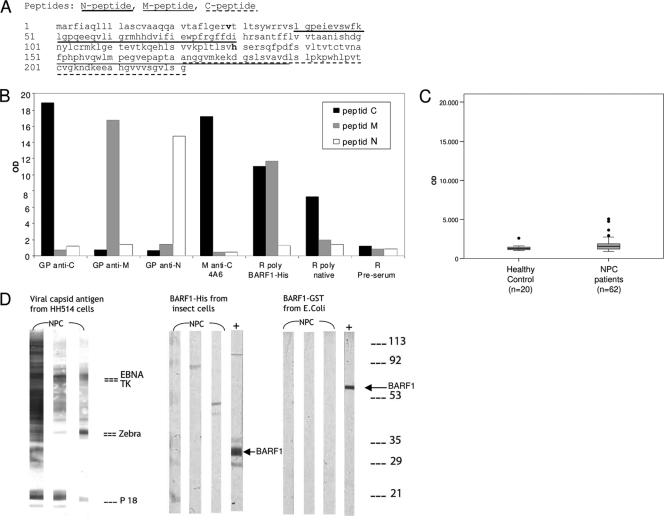FIG. 1.
BARF1 (peptide) sequence and specific animal antibody reactivity against B95-8-derived recombinant BARF1 protein and antigenic peptides. (A) BARF1 sequence containing 2 common amino acid substitutions, V29A and H130R, found in Indonesian isolates (boldface). Antigenic peptides designed by computer analysis, named N peptide (aa 40 to 79), M peptide (aa 151 to 188), and C peptide (aa 187 to 221), are underlined. (B) Antibody reactivity to peptides measured in ELISA. Guinea pig antibodies against C peptide, M peptide, N peptide, and mouse monoclonal anti-C peptide (4A6) specifically react to their target peptides. The rabbit polyclonal antibody anti-BARF1-His (K150.3) binds to both C and M peptides. Rabbit polyclonal antibody raised against the purified native sBARF1 reacts to the C peptide. (C) Antibody reactivity of healthy individuals and NPC patients to the BARF1 C peptide measured in IgG ELISA, showing slightly elevated levels in NPC patients. (D) IgG immunoblot analysis of 3 representative NPC sera with BARF1-His expressed by the Sf9 insect cell expression system and BARF1-GST expressed by E. coli. HH514-derived viral capsid antigens were used as a positive control for EBV antibody presence in patient sera. Guinea pig anti-C peptide antibody (+) showed a clear band on the blot strips, but no BARF1 reactivity was detected in the patient sera despite the presence of diverse antibody responses to other EBV proteins, as visualized on the HH514 strips.

